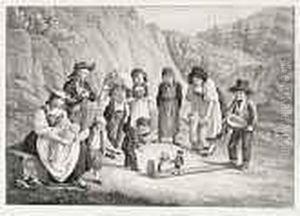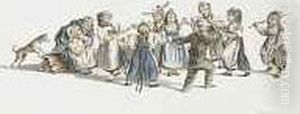Joseph Brodtmann Paintings
Joseph Brodtmann was a Swiss lithographer and publisher born in 1787 in Zurich, Switzerland. His work is not as widely known as some of his contemporaries, and details about his personal life are relatively scarce compared to more famous artists of his time. However, Brodtmann made significant contributions to the field of lithography, a printmaking technique that was relatively new at the time.
Brodtmann's lithographs are particularly noted for their detail and precision, often focusing on natural history subjects such as animals and plants, as well as ethnographic images. He was active during a period when there was a high demand for such images, partly due to the burgeoning interest in science and exploration during the 19th century. Brodtmann's work catered to this curiosity by providing visuals that could be used for educational purposes or simply to satisfy the burgeoning public interest in the natural world.
Throughout his career, Brodtmann worked in various cities, including Zurich and Schaffhausen. He established his own publishing firm, which allowed him to exert more control over the production and distribution of his work. This firm contributed to the dissemination of scientific knowledge by producing high-quality images that were both accessible and accurate.
Brodtmann's lithographs were often based on drawings by other artists, which he skillfully translated onto lithographic stones. This process involved drawing the image on a flat stone with a grease-based medium and then using a chemical process to fix the image onto the stone. The stone could then be inked and pressed onto paper to create a print. Brodtmann's skill in this medium was evident in the clarity and detail of his prints, which were often published as part of collections or natural history books.
Joseph Brodtmann died in 1862, leaving behind a body of work that continues to be appreciated for its artistic and scientific value. His lithographs are held in various museum collections and are studied by those interested in the history of printmaking and scientific illustration. While Brodtmann may not have achieved the same level of fame as some of his peers, his contribution to the world of lithography and natural history illustration has ensured that his work is still respected and valued by historians and collectors today.
![[animals]: Eight Plates](https://www.niceartgallery.com/imgs/440085/s/joseph-brodtmann-animals-eight-plates-728e8b83.jpg)
![[ethnology Studies]: Twelve Plates](https://www.niceartgallery.com/imgs/440084/s/joseph-brodtmann-ethnology-studies-twelve-plates-a56c0bdb.jpg)

